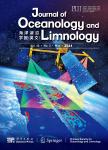Sporo-pollen Assemblage and Paleoclimate Events in Shelf Area of the Southern Yellow Sea Since 15 ka B.P.
Sporo-pollen Assemblage and Paleoclimate Events in Shelf Area of the Southern Yellow Sea Since 15 ka B.P.作者机构:Institute of Oceanology Chinese Academy of Sciences
出 版 物:《Chinese Journal of Oceanology and Limnology》 (中国海洋湖沼学报(英文版))
年 卷 期:2004年第22卷第1期
页 面:44-53页
核心收录:
学科分类:07[理学] 070601[理学-气象学] 0706[理学-大气科学]
基 金:Project 496762 93supportedbytheNSFC
主 题:southern Yellow Sea Quaternary sporo-pollen assemblage paleoclimate events environment evolution
摘 要:Based on the authors’1986 to 1994 sporo-pollen assemblage analysis in the southern Yellow Sea area, data from 3 main cores were studied in combination with 14C, palaeomagnetic and thermoluminescence data. The evolution of the paleoclimate environments in the southern Yellow Sea since 15ka B.P. was revealed that, in deglaciation of the last glacial period, the climate of late glaciation transformed into that of postglaciation, accompanied by a series of violent climate fluctuations. These evolution events happened in a global climate background and related to the geographic changes in eastern China. We distinguished three short-term cooling events and two warming events. Among them, the sporo-pollen assemblage of subzone A 1 showed some cold climate features indicating that a cooling event occurred at about 15-14ka. B.P. in early deglaciation. This subzone corresponds to the Oldest Dryas. In subzone A 3, many drought-enduring herbal pollens and some few pollens of cold-resistant Picea, Abies, etc. were found, which indicated that a cooling event, with cold and arid climate, occurred at about 12-11ka. B.P. in late deglaciation. This subzone corresponds to the Younger Dryas. The sporo-pollen assemblage of zone B showed warm and arid climate features in postglaciation. Although the assemblage of subzone B 2 indicated a cold and arid climate environment, the development of flora in subzone B 2 climate was less cold than that in A 3. Subzone B 2 indicated a cooling event which occurred at about 9ka B.P. in early Holocene. Subzone A 2, with some distinct differences from subzone A 1 and A 3, indicated a warming event which occurred at 14-13ka. B.P. and should correspond to a warming fluctuation. The sporo-pollen assemblage of zone C showed features of warm-moist flora and climate, and indicated a warming event which universally occurred along the coast of eastern China at 8-3ka B.P. in middle Holocene, and its duration was longer than that of any climate events mentioned a



